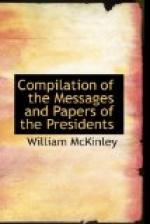In April, 1896, the evils from which our country suffered through the Cuban war became so onerous that my predecessor made an effort to bring about a peace through the mediation of this Government in any way that might tend to an honorable adjustment of the contest between Spain and her revolted colony, on the basis of some effective scheme of self-government for Cuba under the flag and sovereignty of Spain. It failed through the refusal of the Spanish government then in power to consider any form of mediation or, indeed, any plan of settlement which did not begin with the actual submission of the insurgents to the mother country, and then only on such terms as Spain herself might see fit to grant. The war continued unabated. The resistance of the insurgents was in no wise diminished.
The efforts of Spain were increased, both by the dispatch of fresh levies to Cuba and by the addition to the horrors of the strife of a new and inhuman phase happily unprecedented in the modern history of civilized Christian peoples. The policy of devastation and concentration, inaugurated by the Captain-General’s bando of October 21, 1896, in the Province of Pinar del Rio was thence extended to embrace all of the island to which the power of the Spanish arms was able to reach by occupation or by military operations. The peasantry, including all dwelling in the open agricultural interior, were driven into the garrison towns or isolated places held by the troops.
The raising and movement of provisions of all kinds were interdicted. The fields were laid waste, dwellings unroofed and fired, mills destroyed, and, in short, everything that could desolate the land and render it unfit for human habitation or support was commanded by one or the other of the contending parties and executed by all the powers at their disposal.
By the time the present Administration took office, a year ago, reconcentration (so called) had been made effective over the better part of the four central and western provinces—Santa Clara, Matanzas, Havana, and Pinar del Rio.
The agricultural population to the estimated number of 300,000 or more was herded within the towns and their immediate vicinage, deprived of the means of support, rendered destitute of shelter, left poorly clad, and exposed to the most unsanitary conditions. As the scarcity of food increased with the devastation of the depopulated areas of production, destitution and want became misery and starvation. Month by month the death rate increased in an alarming ratio. By March, 1897, according to conservative estimates from official Spanish sources, the mortality among the reconcentrados from starvation and the diseases thereto incident exceeded 50 per cent of their total number.




